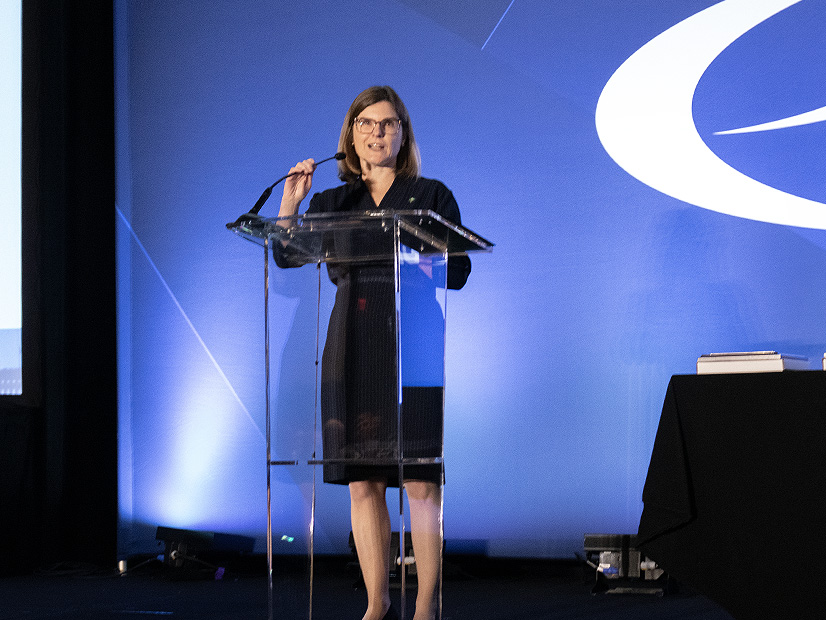WASHINGTON — Utility regulators should see planning for the grid’s transition as a practical — rather than political — act, FERC Commissioner Allison Clements told the Energy Bar Association’s annual meeting Thursday.
The nation’s grid is old and in need of upgrades, which will have to be resilient against increasing instances of extreme weather and cyber and physical attacks, while accommodating the changing resource mix. All those issues generate plenty of political debate, but Clements said it’s not her job to wade into that.
“It is the regulator’s job, and the utilities we regulate, and the stakeholders who are interested in the outcomes of that regulation, to protect customers and maintain reliability in the face of these challenging realities,” Clements said.
FERC and others with responsibility over the power system must tackle all the small and very large problems those changes produce at the same time. One of the biggest keys to it all is changing how transmission gets built.
“Right now, today, there is money on the table,” Clements said. “There is efficiency in the existing transmission system that we are not taking advantage of. And as I’ve been joking lately, I never thought in my life that I would become a cheerleader for something called grid enhancing technologies [GETs]. But I am a cheerleader for these things.”
GETs do involve changing the way the grid is run, but they are simple technologies and offer massive savings compared with building more transmission. Brattle Group has estimated that GETs could help integrate twice the volume of renewables as exist today without expanding transmission at all, so even if the real number is just 50% more renewables, that means massive savings, Clements said.
Tapping into the demand side can also make that transition easier, as evidenced by the 1.2 GW cut in demand resulting from a text message sent out by California’s government during last September’s heatwave. The text has come under criticism for scaring some consumers into thinking the grid was collapsing, but Clements said it at least showed there is plenty of untapped potential on the demand side.
“It’s not to suggest that we should go around scaring people by asking them to reduce demand,” Clements said. “The reality is that’s an opportunity that can be systematized.”
‘Never-ending Lunch Line’
FERC does have a role as it continues to work through issues around Order 2222 compliance, which required RTOs and ISOs to open their markets to aggregations of distributed energy resources.
The demand side and GETs are some of the “small things” that can help address the grid’s transition, but FERC is also focused on the larger issue of trying to clear out the 2,000 GW backlog in the country’s interconnection queues. (See LBNL: Interconnection Queues Grew 40% in 2022.)
“It’s like a never-ending lunch line, right?” Clements said. “You just wait and wait and wait. And it’s hard, and it’s expensive, and you lose efficiency and resources drop out of line.”
FERC has issued a Notice of Proposed Rulemaking (NOPR) that includes reforms that emerged as best practices around the country such as dealing with projects on a first-ready, first-served basis and processing them in clusters instead of one at a time. But the interconnection queues also need broader transmission planning reforms, which are the subject of another pending NOPR at the commission.
“I don’t think interconnection gets you all the way there, if you don’t fix the transmission system planning, and this maybe is perhaps the hardest, and the longest term,” said Clements. “But again, it’s a thing that FERC has taken action on. We issued a bipartisan proposal to improve regional transmission system planning and cost allocation.”
A major feature of that NOPR is longer-term scenario-based transmission planning that tries to figure out where generation and load will come from in the future and plan accordingly. It is impossible to predict the future, but by studying different scenarios, planners could come up with grid upgrades that produce significant benefits in multiple scenarios, Clements said.
Clements pointed to Edison Electric Institute figures showing that investor-owned utilities invested almost $28 billion in transmission in 2021, a figure that rose to about $30 billion last year.
“That’s the status quo,” she said. “So, whether or not FERC takes action on this rule, money is getting spent. Customers are ultimately holding the bag for that, right? We need to help direct that investment to a way where customers get the most bang for their buck — the most benefit at the lowest cost. And I think that this proposal has the opportunity to do that. Of course, we have to finalize it.”



